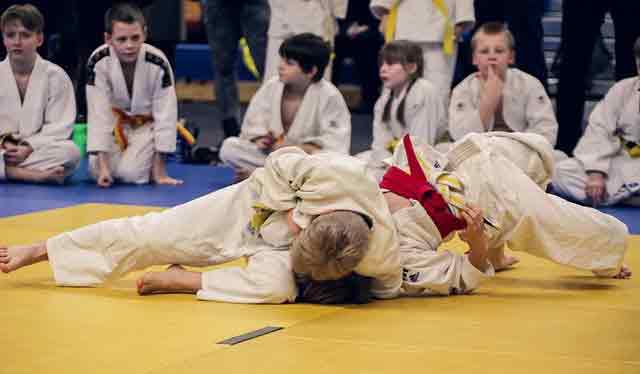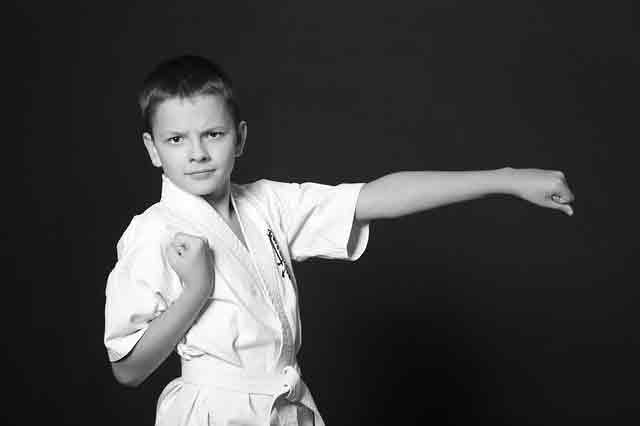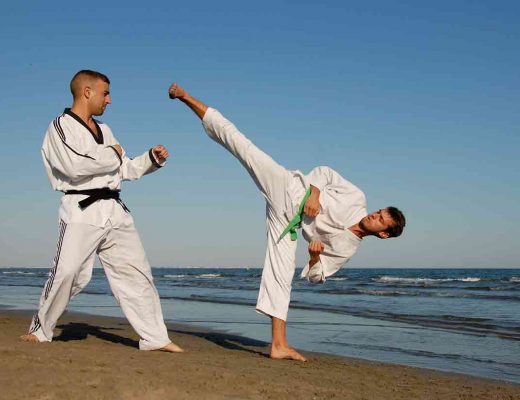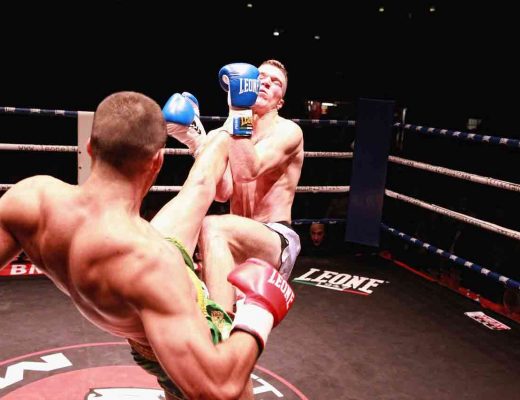Introduction
We all know that martial arts help instill discipline and confidence, while also promoting exercise and good health.
This has prompted many parents to consider enrolling their child in a martial arts program.
But with so many different martial arts out there, how do you know which one to pick to enroll your child in?
And what are the best martial arts for kids?
Should you pick a traditional martial arts like Karate, Kung Fu, or Taekwondo?
Or
Should you pick something more modern like mixed martial arts?
In this article, I will go over some of the best martial arts for kids.
These include:
- Taekwondo
- Karate
- Wushu
- Judo
- Brazilian Jiu Jitsu
For the purposes of this article, I will be defining children as between the ages of 4-12 years old.
Taekwondo

Taekwondo has long been a favorite among parents due to its safe and fun learning environment for kids.
Taekwondo is a Korean martial art that originated in Korea and has since then become quite popular all around the world and is even an Olympic sport.
Taekwondo practitioners are known for having very powerful leg kicks, and being extremely flexible.
While kicking does make up a significant amount of the curriculum, punches, blocks, and some self defense techniques are also taught.
Sparring is also encouraged during classes to help students develop timing, reflexes, footwork, and confidence in applying what they have learned in a controlled setting.
Typically students wear a plethora of protective gear during sparring sessions to ensure the upmost safety for all participants.
Taekwondo is a great starter martial arts for kids due to its emphasize on developing strong martial arts fundamentals, in addition to teaching discipline, respect, and humility which a lot of modern martial arts seem to lack.
For a more in-depth look at whether Taekwondo is the right fit for your child, check out this article that I wrote:
Pros and cons of learning Taekwondo.
Best suited for: Kids with a lot of energy to burn that love striking objects, especially kicking.
Karate

Karate was a martial arts developed in Okinawa, Japan and is translated in English as “way of the empty hand”.
Like its close cousin Taekwondo, it shares many similarities as well differences between the two martial arts.
Uniforms and belt ranking systems are almost universally identical with each other, and many punches and kicks look like carbon copies of each other, however the road diverges when it comes to the emphasize and philosophies of the two martial arts.
While Taekwondo has a heavy focus on kicking and even the competition side of things, karate on the other hand focuses more on hand strikes with kicks supplementing it.
There’s also a much greater emphasize on stances compared to Taekwondo.
Self defense, patterns (kata’s), and sparring also make up the curriculum in a karate program.
And in case your child ever dreams about competing professionally, know that in the upcoming summer Olympics in Tokyo in 2020, expect Karate to make its debut as an official Olympic sport!
For a more detailed look at the difference between karate and taekwono, check out this article.
Best suited for: Kids that need discipline, self confidence and love to punch and perform patterns.
Wushu

Wushu is a Chinese martial art that literally means martial arts in Mandarin.
It was invented in China and encompasses a combination of different martial arts all woven together to standardize traditional Chinese martial arts by the government in 1949.
Unlike the former two martial arts, wushu is known for being quite graceful and fluid in movements rather than linear and rigid as in Karate.
In Wushu, students are taught both hard and soft styles of Chinese martial arts such as Shaolin Kung Fu and Tai Chi.
Hard styles basically mean that you meet force with force such as blocking a punch, whereas soft styles use the opponents force against them by either redirecting their force or making them off balance.
A lot of martial artists and movie stars that you have seen on TV come from a Wushu background such as Jet Li and Donnie Yen.
If you’ve seen any of their movies then there’s no doubt that you’ve probably seen some Wushu moves being performed on screen.
Best suited for: Children that are easily bored and need variety and want to be able to perform moves similar to what they see on TV.
Judo

Judo is a Japanese martial art that originated in Japan and focuses on throws, take downs, joint locks, and chokes rather than strikes.
Furthermore, students learn how to fall properly so as to minimize pain and damage.
This can come in quite handy during a bully confrontation if the child were to get pushed and shoved to the ground.
Not only is Judo good for fitness and self discipline, it also teaches self defense that can be applied in real life.
Rather than learning how to strike opponents like some of the other martial arts, students are taught rather how to subdue opponents.
During free style practice also known as Randori, students are encouraged to apply what they have learned in a controlled and supervised environment.
As a self defense martial art, Judo is quite useful, as it teaches students how to take down and subdue attackers.
Also keep in mind some schools have minimum age requirements before a student is allowed to enroll at that school.
Children usually start out only learning how to roll, fall down, and perform basic throws, and maybe take downs, which makes it safe for children to learn Judo.
Best suited for: Children that love to wrestle and learn throws.
Brazilian Jiu Jitsu?

Brazilian Jiu Jitsu is a martial art developed in Brazil with influence from Japanese Jiu Jitsu and Judo.
Like Judo, Brazilian Jiu Jitsu focuses on ground fighting and submissions rather then strikes.
The goal of a Brazilian Jiu Jitsu specialist is to subdue their opponents by take down and then submitting them usually either through a choke or a joint lock like an arm bar or kimura.
Although safe in a controlled environment, there are some inherent risks involved in training Brazilian Jiu Jitsu despite the low incidence of injury, this is especially true for competitions.
In a research study that examined common injuries in a Brazilian Jiu Jitsu tournaments, the authors found that hyper-extension of the elbow via an arm bar was the most common injury.
Furthermore, cauliflower ear is another inherent risk involved with Brazilian Jiu Jitsu, whereby the ear develops into a cauliflower like appearance due to trauma that causes fluids to fill up and harden. If left untreated, the ear will take this shape permanently. Headgear can be worn to safeguard against this though.
Lastly, neck injuries are quite common in Brazilian Jiu Jitsu practice.
Its not uncommon to be put in some sort of position that puts a lot of pressure on your neck usually via a choke submission such as a rear naked choke or a guillotine choke.
With children, self control and discipline will become issues when it comes to applying techniques being taught in a class.
It is therefore of crucial importance that parents select a school with excellent instruction and supervision to avoid these potential injuries.
Due to these inherent risks being present in Brazilian Jiu Jitsu, I would caution parents to be extra vigilante if they do decide to allow their children to study this martial art.
Best suited for: Children that want to grapple and learn submissions.
Not Recommended for Children

While seeing kids doing all sorts of cool martial arts moves and competing in full contact sparring tournaments or even MMA might look cool on TV, it isn’t so nice when your kid is on the receiving end of the stick and has to be carried away on a stretcher!
Here are some martial arts that I do not recommend at all for children that are between the ages of 4-12.
- Mixed Martial Arts
- Boxing
- Kickboxing
- Muay Thai
It blows my mind how careless some parents are to think that they could enroll their 5 or 6 year old kid in MMA to live out their UFC fantasy of having a son or daughter that is a UFC fighter and not put significant risk of injury for their child.
It has been well documented since 1928 in boxers that repeated head trauma can lead to a condition known as chronic traumatic encephalopathy (CTE) whereby repetitive brain injury leads to progressive degenerative disease of the brain. Furthermore, there have even been several hundred documented cases of fatalities from boxing and prize fighting!
Now while things have gotten a lot better over the century and new rules have been introduce to safe guard participants, it is still an undeniable fact that any sort of combat sport that allows participants to receive repeated head injuries does significantly increase their risk of developing any sort of brain injury.
This is especially crucial for children that are still growing up. Their skulls and brain are still growing at that age, and therefore are much more fragile and susceptible to injuries compared to an adult.
Any sort of injury during this period of time, could have long term detrimental effects for the child’s brain and bone development.
In all of those martial arts that I listed above, repeated striking to one’s head is a generally accepted part of sparring and even competitions, even if protective headgear and equipment are being worn.
Just imagine, two kids that are goofing off during a sparring session in a boxing class, when suddenly one of them takes a wild swing and ends up knocking the other kid out cold with a hook across the head, sending him down to the canvas.
Remember folks, your dealing with children here, not teens or adults. Their behavior will be very unpredictable.
Whereas an adult or even a teen would have much more control over their punches or kicks, a child of such young age would not.

And this is just the tip of the iceberg in terms of injuries.
Bruised and broken ribs that lead to difficulty breathing, facial lacerations and injuries such as broken noses, cuts from punches and elbows, hand fractures, and even dislocated shoulders are all present in the above list of martial arts and combat sports.
While these types of bodily injuries would not likely occur at a school, in a tournament its a completely different story.
At tournaments, the objective is to beat your opponent to win and therefore the chances of injuries increases significantly.
A child simply does not possess the same level of self awareness and control when applying techniques as an adult.
Due to the nature of these martial arts and the high likelihood of getting injured in key vital areas such as the head and brain, I do not recommend these martial arts for children.
However once the child is a bit older and has developed a bit more maturity and growth in their bodies, participating in these martial arts would be much more safer.
Conclusion
In this article we examined several different martial arts that are safe and appropriate for children.
These include:
- Taekwondo
- Karate
- Wushu
- Judo
- Brazilian Jiu Jitsu (with reservations)
All of these martial arts teach self discipline, self defense, and promote cardiovascular exercise, and are great starting martial arts for kids.
Furthermore, we discussed several additional martial arts that should be avoided for children such as:
- Boxing
- Muay Thai
- Mixed Martial Arts
- Kickboxing
These martial arts and combat sports have higher risks of injuring the head and brain and therefore cause brain trauma that can lead to a condition known as chronic traumatic encephalopathy (CTE). While a teenager or adult would be able to exercise more control and caution when participating in these types of martial arts, a child however, would not.
It is therefore in my opinion not recommended to enroll a child in these martial arts until they are older and exhibit more maturity and control.




No Comments